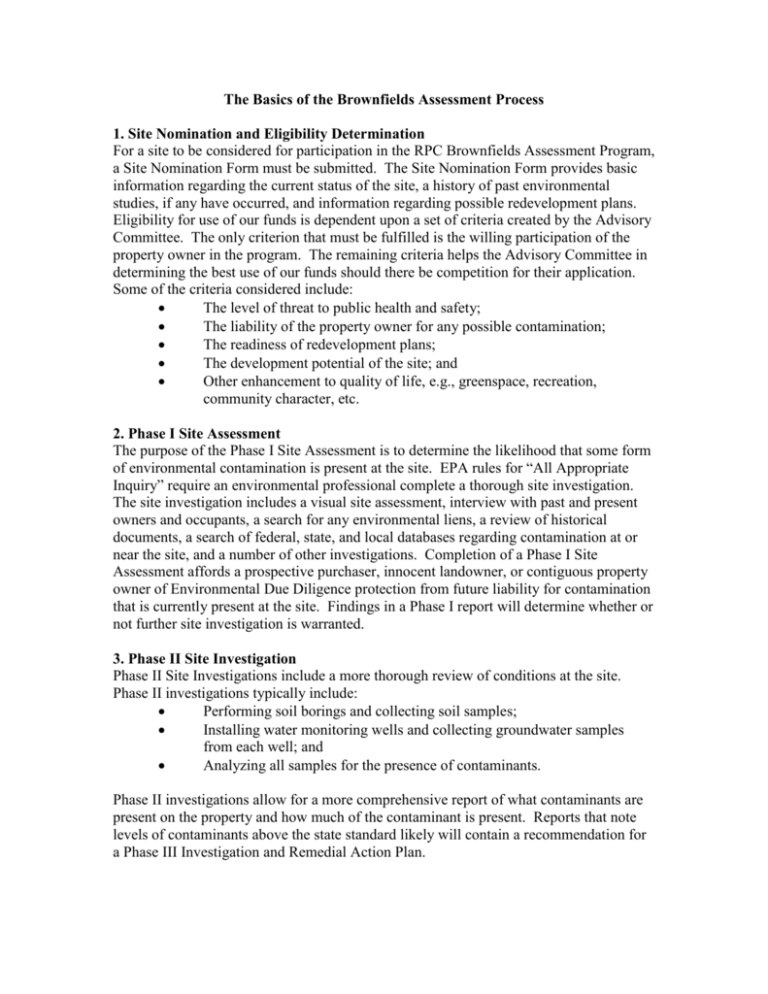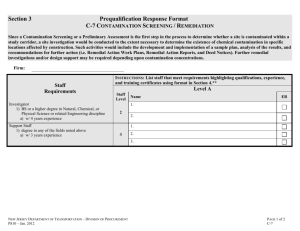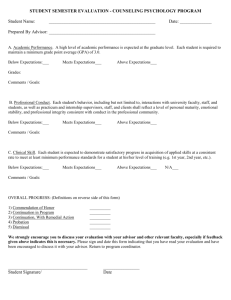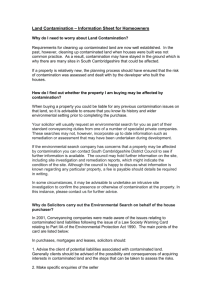The Basics of the Brownfields Assessment Process
advertisement

The Basics of the Brownfields Assessment Process 1. Site Nomination and Eligibility Determination For a site to be considered for participation in the RPC Brownfields Assessment Program, a Site Nomination Form must be submitted. The Site Nomination Form provides basic information regarding the current status of the site, a history of past environmental studies, if any have occurred, and information regarding possible redevelopment plans. Eligibility for use of our funds is dependent upon a set of criteria created by the Advisory Committee. The only criterion that must be fulfilled is the willing participation of the property owner in the program. The remaining criteria helps the Advisory Committee in determining the best use of our funds should there be competition for their application. Some of the criteria considered include: The level of threat to public health and safety; The liability of the property owner for any possible contamination; The readiness of redevelopment plans; The development potential of the site; and Other enhancement to quality of life, e.g., greenspace, recreation, community character, etc. 2. Phase I Site Assessment The purpose of the Phase I Site Assessment is to determine the likelihood that some form of environmental contamination is present at the site. EPA rules for “All Appropriate Inquiry” require an environmental professional complete a thorough site investigation. The site investigation includes a visual site assessment, interview with past and present owners and occupants, a search for any environmental liens, a review of historical documents, a search of federal, state, and local databases regarding contamination at or near the site, and a number of other investigations. Completion of a Phase I Site Assessment affords a prospective purchaser, innocent landowner, or contiguous property owner of Environmental Due Diligence protection from future liability for contamination that is currently present at the site. Findings in a Phase I report will determine whether or not further site investigation is warranted. 3. Phase II Site Investigation Phase II Site Investigations include a more thorough review of conditions at the site. Phase II investigations typically include: Performing soil borings and collecting soil samples; Installing water monitoring wells and collecting groundwater samples from each well; and Analyzing all samples for the presence of contaminants. Phase II investigations allow for a more comprehensive report of what contaminants are present on the property and how much of the contaminant is present. Reports that note levels of contaminants above the state standard likely will contain a recommendation for a Phase III Investigation and Remedial Action Plan. 4. Phase III Site Investigation and Remedial Action Plan Phase III Investigation and Remedial Action Plan is typically the final stage of a Brownfields Assessment Program. Phase III investigations may consist of the additional collection of soil and groundwater samples and continued investigation of any anomalies discovered during the Phase II investigation. The Remedial Action Plan consists of a Soils and Material Management Plan for off-site disposal or on-site reuse of impacted soil, suggestions for ongoing groundwater monitoring, a list of permit requirements needed to engage in remedial action, and suggestions for the use of institutional controls such as activity use restrictions. Completion of a Phase III/Remedial Action Plan triggers the necessity of on-site cleanup. Parties that have been found not liable for contamination will receive a covenant not to sue from the EPA or NH DES. This covenant is valid under certain conditions including reasonable steps that current owners/purchasers of the property must take in order to stop the current release of the contamination, prevent any further releases, and prevent or limit human, environmental, or natural resource exposure to any hazardous substance released on or from the property. These are typical goals of a Remedial Action Plan 5. Environmental Clean-up and Site Redevelopment There are a number of low-interest rate revolving loans available for clean-ups and eligibility for those loans varies. It is important for prospective purchasers, and most important for current property owners that may be held liable for contamination, to determine their eligibility for these loans prior to determining their participation in the RPC Brownfields Assessment Program. Some grant funds are available for clean-up but such funds are highly competitive. RPC cannot provide funds for site clean-up or redevelopment but we are able to provide information that will assist a property owner or prospective purchaser in finding organizations that provide clean-up assistance funds.











